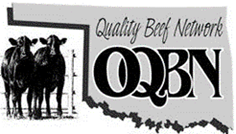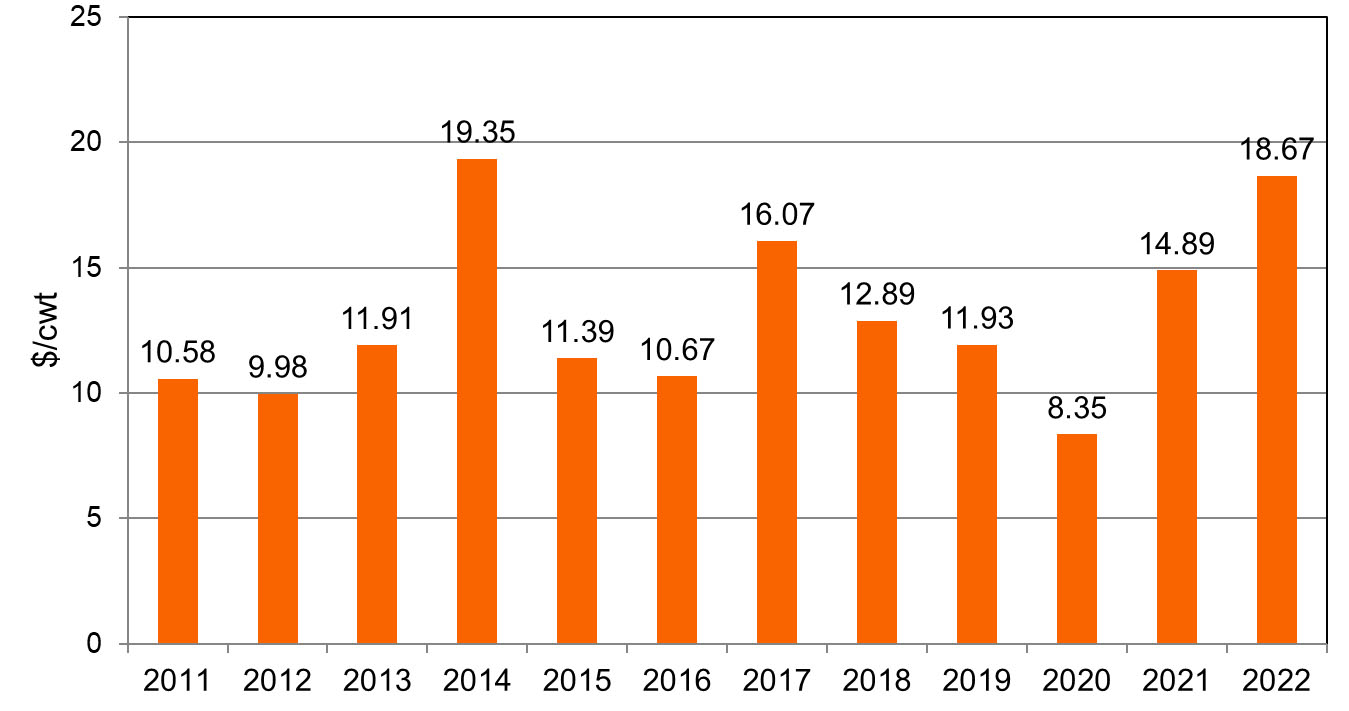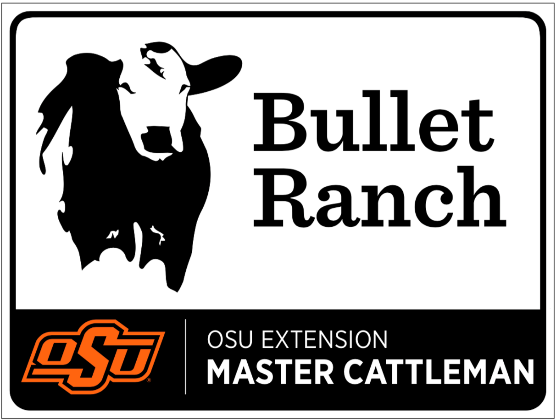Cow-Calf Corner | August 28, 2023
Plan Now for Value-Added Calf Marketing This Fall
Derrell S. Peel, Oklahoma State University Extension Livestock Marketing Specialist
Kellie Curry Raper, Oklahoma State University Extension Livestock Market Economist
 Calves that are preconditioned at weaning are healthier and more resilient to withstand
the rigors of shipping and commingling prior to introduction in subsequent production
programs. Preconditioning can add significant value to calves but requires planning
and management. The Oklahoma Quality Beef Network (OQBN) is one program that allows
producers to capture added value for calves. Table 1 shows the OQBN sales scheduled
for the remainder of 2023 and the associated weaning dates. A 45-day weaning period
is the minimum required for calves to qualify for OQBN. However, research has confirmed
a significant premium for fall-marketed calves weaned 60 days or more.
Calves that are preconditioned at weaning are healthier and more resilient to withstand
the rigors of shipping and commingling prior to introduction in subsequent production
programs. Preconditioning can add significant value to calves but requires planning
and management. The Oklahoma Quality Beef Network (OQBN) is one program that allows
producers to capture added value for calves. Table 1 shows the OQBN sales scheduled
for the remainder of 2023 and the associated weaning dates. A 45-day weaning period
is the minimum required for calves to qualify for OQBN. However, research has confirmed
a significant premium for fall-marketed calves weaned 60 days or more.
Preconditioning adds value to calves due to the weaning, health and other management protocols that are included in the programs. Certification adds additional value by providing assurance to buyers that preconditioning programs have been completely and properly implemented. The value of each of the preconditioning program components has been verified by years of data and research along with the additional value of certification. More information about OQBN programs, protocols and sales is available at Oklahoma Quality Beef Network | Oklahoma State University (okstate.edu).
Table 1. 2023 Oklahoma Quality Beef Network (OQBN) Sales, Locations, and Wean Dates
| Sale Date | Location | 45-Day Wean Date | 60-Day Wean Date |
|---|---|---|---|
| November 7, 2023 | OKC West (El Reno) | September 23, 2023 | September 9, 2023 |
| November 14, 2023 | McAlester | September 30, 2023 | September 15, 2023 |
| November 15, 2023 | Payne County (Perkins) | October 1, 2023 | September 16, 2023 |
| November 20, 2023 | Southern Plains (Blackwell) | October 6, 2023 | September 21, 2023 |
| November 28, 2023 | OKC West (El Reno) | October 14, 2023 | September 29, 2023 |
| December 9, 2023 | LeFlore County (Wister) | October 25, 2023 | October 10, 2023 |
| December 12, 2023 | OKC West (El Reno) | October 28, 2023 | October 13, 2023 |
As with any economic decision, producers should evaluate the costs and returns of preconditioning programs. Additional costs of preconditioning vary across operations and situations and, while there is no guarantee of positive returns, the probability of positive returns is higher and more consistent in recent years. Figure 1 shows the average premiums of OQBN calves compared to calves sold without preconditioning. Over the previous 12 years, OQBN premiums have averaged $13.05/cwt. It is important to remember that OQBN calves sell at a premium to calves not preconditioned and, also at heavier weights compared to the beginning of weaning. Producers may feel that the current high prices for calves makes the value of preconditioning less, but Figure 1 shows that the highest average premium for OQBN occurred in 2014 at the time of the previous record high cattle prices. For buyers, the reduced risk of animal morbidity and mortality due to preconditioning is more valuable when the cost of the animals is higher.
*OQBN premium calculated as difference in weighted average prices over calves marketed with no preconditioning at same sale ($/cwt).
Figure 1. OQBN Weight Average Premium, 2011-2022
Marketing calves for added value requires two steps: first, complete the health and management requirements of the preconditioning program and second, market the animals in a manner that buyers who demand and value preconditioned calves will have the best opportunity for purchase. OQBN sales are scheduled with partner auctions to attract the volume of both buyers and certified preconditioned cattle to result in better markets and value for the calves.
Anaplasmosis in Cattle
Mark Z. Johnson, Oklahoma State University Extension Beef Cattle Breeding Specialist
Anaplasmosis is a common disease in cattle with worldwide distribution. The disease is regularly found in cattle in the state of Oklahoma. Accordingly, Anaplasmosis will occur every year within Oklahoma with some variation on the intensity of this disease usually based on the strain of Anaplasma marginale which is a bacteria that infects red blood cells and once an animal becomes infected they are infected for life. Anaplasmosis is transmitted through the bite of ticks and flies, as well as blood contaminated instruments like needles, tattoo tools, castration equipment and dehorning instruments. This bacteria does not harm the red blood cells directly but the cow’s immune response recognizes it when it reaches certain levels which then causes anemia due to the immune system killing the red blood cells that are infected. This will limit the amount of oxygen that is transported throughout the animal’s blood, which can then lead to aggressive behaviors exhibited by normally docile cows or bulls. Other clinical signs that animals are infected with the bacteria are extreme lethargy, yellowing of the mucous membranes, abortions, weight loss, and difficulty breathing. Most producers will not know they have an anaplasmosis problem until they see dead cows or bulls that are older than 2-years of age. This disease can be devastating with death losses in some herds approaching 50%.
Best Management Practices for Treatment and Prevention
First, consult with your veterinarian so that they can develop a comprehensive plan to limit the impact of anaplasmosis. This relationship is important because the most commonly utilized control plan is to administer tetracycline antibiotics through mineral supplements or feed and the only access to this preventative treatment is to obtain a Veterinary Feed Directive (VFD). Clinical signs of infections can be treated with injectable antibiotics via an intramuscular injection of oxytetracycline administered multiple days and should be given under a veterinarian’s directions. Successful antibiotic therapy curing the clinical signs of infection results in a carrier animal. Carrier cattle will be immune to further disease from anaplasmosis but will remain a source from which needles, flies and ticks can spread the disease. A vaccine is available in some states and Oklahoma is approved for this vaccine. This vaccine does not prevent infection but anecdotal evidence demonstrates a reduction in clinical signs.
In Oklahoma it is not a matter of “if” but rather a matter of “when” anaplasmosis will impact your cattle herd. Best management practices to prevent and control the transmission of this disease include:
- Feeding tetracycline antibiotic during the fly and tick seasons (essential)
- Rotating pastures (when possible) to avoid pastures with a history of tick issues during tick season
- Burning pastures in the spring to control ticks
- Controlling fly and tick populations to the extent possible
- Changing needles and disinfecting any instruments which may result in transmitting blood from animal to animal when working cattle.
Reference: Anaplasmosis: People, Ticks and Certain Flies. Justin Talley. Cow-Calf Corner Newsletter. June, 2021.
Why Become a Master Cattleman?
Kellie Curry Raper, OSU Livestock Marketing Specialist
David Lalman, OSU Beef Cattle Extension Specialist
Maybe you’ve seen the gate signs on a neighbor’s fence or barn. Maybe you’ve seen a promotional flyer at the county fair or posted on social media. Maybe you’ve heard someone refer to something they learned in their Master Cattleman class. And maybe you are asking “what is Master Cattleman and why should I consider it?”
Oklahoma State University’s Master Cattleman program is in its 20th year and, to date, has over 1500 graduates. Master Cattleman is a producer education program conducted through OSU Extension at the county level. The course focuses on research-based learning made practical for “on the ranch” implementation. Producers interact with experts across multiple topic areas, and – just as importantly – the group setting also allows them to learn from each other.
The Oklahoma Beef Cattle Manual is used as the textbook for the course and is provided as part of the course materials at enrollment. Note that the Manual is also available in Spanish. Cattlemen work through a minimum of 28 hours (i.e., chapters) in a mix of in-person lecture, discussion, and hands-on learning. Sixteen of those hours are required chapters for every Master Cattleman class and cover topics ranging from business planning and marketing to forage management and animal health. You can see the Oklahoma Beef Cattle Manual Table of Contents. The other 12 credit hours are flexible, so Extension educators and class members can choose which chapters are most useful for the class based on the group’s interests and needs. Those who complete the 28-hour requirement receive a graduation certificate, a portfolio notebook embossed with the Master Cattleman logo, and a personalized Master Cattleman gate sign.
So why should you consider becoming a Master Cattleman? In program evaluation surveys, 2018 graduates estimated annual improvement in their cattle operation’s profitability at an average of $3,700 per year. Nearly 90% of Master Cattleman graduates say they still refer to their Beef Cattle Manual at least once a month. Classes are composed of men, women, neighbors, husbands, wives, sons, daughters…and producers of all sizes. Chances are there is someone in the class who faces some of the same challenges that you face in your cattle operation. A few folks have found it so practical that they’ve taken it twice!
You can find more information on the Master Cattleman program. If you are interested in taking the Master Cattleman course, contact your county Extension educator or let us know through the contact form on the website or at mastercattleman@okstate.edu and we’ll share that information with them.


